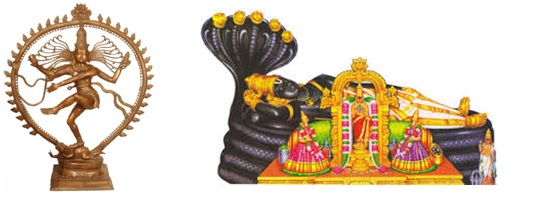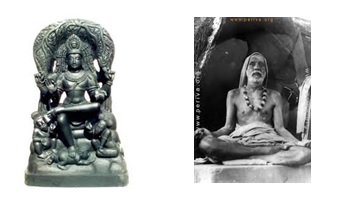In most of our temples, the principal deity faces the east: Parthasarathy temple in Chennai, Ekambareswarar and Kamakshi in Kanchi, Meenakshi Sundareswarar in Madurai etc., In a few temples they face the west: Kapaleeswarar in Chennai, Varadarajar in Kanchi are examples, but usually in such temples, the tallest and principal gopuram will be on the eastern side. There are however two notable exceptions, where the principal deity faces south: Chidambaram and Srirangam.
There are similarities between the two. For Shaivaits and Vaishnavaits they are respectively their most important temples. Chidambaram is the foremost among the Panchabootha sthalangal for Shaivaits. Srirangam is the foremost among Vishnu’s eight swayam-vyakata kshetras, or self-manifested shrines and also the most important among the 108 divya kshetrams. In Vaishnava parlance, the term ‘koil’ refers to this temple only.
They are both called ‘rajas’ – Nataraja and Rangaraja. They are both linked with Kalakshetras. ‘Rangam’ means performing stage. It is defined as – ‘Purva ranga prasangaaya natakeeyasya vasthunaha’. Rangam means an elevated stage. The one occupying that stage is Ranga Raja. Lord Nataraja holds court in ‘Kanakasaba’ – saba also means a performing place. Compared to where devotees stand, Lord Nataraja is on an elevated section of the temple. What does He do there? Dance! They both face the south, as if to proclaim to the devotees that they are there to protect them from the threat that comes from the east, mortality, in the hands of the God of Death, Yama. They are both in a state of bliss.
There is a significant difference.

South Facing Gods - Nataraja & Rangaraja
Nataraja is all about motion. He stands for aananda (bliss), expressed in the dynamic rhythm of ecstatic dance. He is not only dancing, but also whirling around, resulting in His matted locks stretched out stiff horizontally – ‘virittha senchadaiyan’ in Tamil. Maheswara sutras peal forth from His dhakka (udukku in Tamil), as He beats it to keep time with His dance and these constitutes the basic alphabets of languag. His right hand is in aananda mudra. Rangaraja is also in a state of bliss, but, stretching Himself at ease in the repose of yoga nidra. ‘Nidra mudra nihila jagathee rakshane jagaruukam’, expressing his state of bliss through Nidra mudra. He is called Anantha Sayana Perumal – lying on the five headed snake.
In fact there is a third deity who always faces the South: Shiva in the form of Dakshinamurthy, but His posture is in stark contrast to that of Nataraja. Dakshinamurthy personifies subdued aananda and seated in silent serenity in a calm pose. Nataraja is dancing with one leg on the ground and the other lofted in a dance pose: Dakshinamurthy is seated with one crossed leg resting on the other. While the locks of hair of one is whirling around, that of the other just glides over His shoulders. The loud sound, or sabdas that emanate from Nataraja are simply embedded in the pages of the book that Dakshinamurthy holds in his left hand. Aananda mudra is expressed by the right hand of Nataraja, while chin mudra is expressed by Dakshinamurthy. To the former, we go for a darshan, to feast our eyes with the supreme majesty of that manifestation: to the latter we go for quite meditation, or japa, because He is the embodiment of the fullness of bliss that comes as a result of jnana.
We say ‘sat-chit-anandam’. Among the pancha bootha sthalangal, Chidambaram represents sky or akasam. ‘Chit’ means consciousness. Ambaram means sky or akasam. Chidambaram therefore refers to the sky of consciousness, one’s ultimate aim in life. Chit also means jnana. Dakshinamurthy’s mudra is ‘chin mudra’. ‘Purna jnanam’ or complete jnana is what results in the ultimate peaceful bliss. It is because of this, often people sit in a pose similar to Dakshinamurthy, when they close their eyes and recite ‘panchakshara’ japam. With open eyes we have the darshan of Nataraja: with closed eyes, we see Dakshinamurthy within us and perform our japam.
Margazhi month is special for worship of both Nataraja – Arudra Darshan, and Rangaraja – Vaikunta Ekadesi. Alangudi near Kumbakonam is considered Guru kshetram with Dakshninamurthy as the principal deity. The most important festival in Alangudi temple falls in the Tamil month of Masi. But, the Aradhana to a living Dakshinamurthy that many of us have all been privileged to see, Kanchi Mahaperiaval, falls in this month.

South Facing Gods - Dakshinamurthy
All the three, the Aananda murti in his Aananda mudra pose, the Dhyaanamurthi in his Chin mudra pose and the Yoginidramurti in his Yoginidra pose, all of them face south as if to protect their devotees from the fear of death. As we enter 2015, may we all pray to the three south facing Gods and say our pranams to Acharyas.